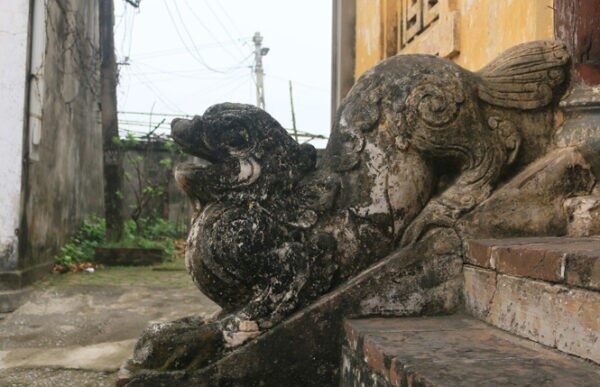Thang Loi commune in Thuong Tin district is famous for its Dao Xa embroidery village with products of exquisite artistic quality and artistic appreance. This place is also the destination of many tourists because of a unique architectural complex including the Dinh Dong, Dinh Tay and Dao Xa pagoda. These three sites were classified as a national historical-cultural site by the Ministry of Culture, Sports and Tourism in 2000.

Three gates communual house in Dao Xa Pagoda
Dao Xa possesses a special and unique feature, 2 adjacent communal houses in a same village. Two communal houses are distinguished by their rustic name: Dong Dinh and Dinh Tay.
Dinh Tay, Dao Xa was originally a temple to worship Chu Dong Tu (one of the four immortals of Vietnamese people) and Tien Dung Princess. According to legend, Chu Dong Tu and Tien Dung accidently passed by Dao Xa village, saw the charming scenery and stopped to rest. Then, the local people built a temple to memorized them. The temple was built during the Chinh Hoa era (1680-1705), during the reign of Le Hy Tong King, with the architecture in the style of “nhi” (=) letter. Later, the temple became a communal house.

Crocodile mascot at Dinh Tay communal house
In front of the Dinh Tay, there is a intact pair of stone crocodiles – popular mascots of the Ly – Tran dynasties. The main altar has 5 steps, the roof is covered with fish scale tiles, embossed two dragons and a pearl, on both sides there is a roof. The distance between the main altar and the upper hall is about 1m, the two sides of the gate are covered with the image of a king’s edict. On both sides of the main altar’s wall, there are two stone steles with text of the renovation of the temple.
Dai Bai has two great Chinese characters “Musical song of the soul” and “Upper class of spirit words” praising the merits of Chu Dong Tu god. The wooden pilar system is placed on stone pedestals, sculpted with sophisticated dragon shapes and the mascots are placed on the beam system.
Dinh Dong was formerly La Co temple, built in the early 20th century in the architectural style of the letter “tam”. The three folds of the house gradually rise from the outside to the inside, the front house has 4 rows of wooden pillars, placed on a stone pillar with a neck-and-neck style, on the left is a stone dog lying with its head facing out. The temple worships the ancestor of embroidery craft, Mr. Le Cong Hanh (1606-1661), originally from Quat Dong village (now Quat Dong commune, Thuong Tin district). Thanks to its great spiritual value, the temple was turned into a communal house and called the Ding Dong, distinguish it from the Dinh Tay worshiping Chu Dong Tu – Tien Dung. Dinh Dong is smaller than Dinh Tay. It served as the place to celebrate the death anniversary of the embroidery ancestor, Le Cong Hanh. The anniversary is held on the 12th of June (lunar calendar) every year.
Located between the two communal houses is Dao Xa Pagoda (Van La Tu). It has a small area with 36 statues arranged in layers from the altar to the upper hall. In the temple yard, there is an incense tree carved with Chinese characters: “Vinh Khanh live forever at At Dau, the five moons and suns of the day” (built in 1729, under Le Duy Phuong King).
Dao Xa is one of the few villages that still retains the architecture of spiritual establishments including communal house – temple – pagoda and the system of yards, gates, ponds and ancient trees. Tam Quan, the common gate for the whole complex, was sculpted in detail. Over time, Tam Quan still preserves an ancient and solemn appearance. Each gate has 2 floors, the bell tower and the opening floor. The main gate has four 15-meter-high Chinese characters “Sun lights and moonshine” witj a large yard that create a solemn appearance of the pagoda.
Dao Xa Village Festival is held on February 12 (lunar calendar), every 5 years. The ceremony is held to bathe Chu Dong Tu God and Tien Dung Princess with water taken from Da Trach lagoon (Hung Yen province). With great historical values, in 2000, Dinh Dong, Dinh Tay and Dao Xa pagoda were recognized as a national historical-cultural site by the Ministry of Culture, Sports and Tourism. In 2009, Dao Xa village was recognized as a traditional profession village by the Hanoi People’s Committee.
Dao Xa is chosen as estination in the journey of cultural and spiritual tourism by many tourists. When visiting Dao Xa, visitors will see the ancient and outstading features of the temple complex with sophisticated and unique features in architecture. They can be immersed in the green, clean and beautiful space of the village. It still retains the features of rural areas in the Northern Delta. Besides, visitors can have more wonderful experiences at Dao Xa embroidery village to understand more about the locality and people here.
An Phu

